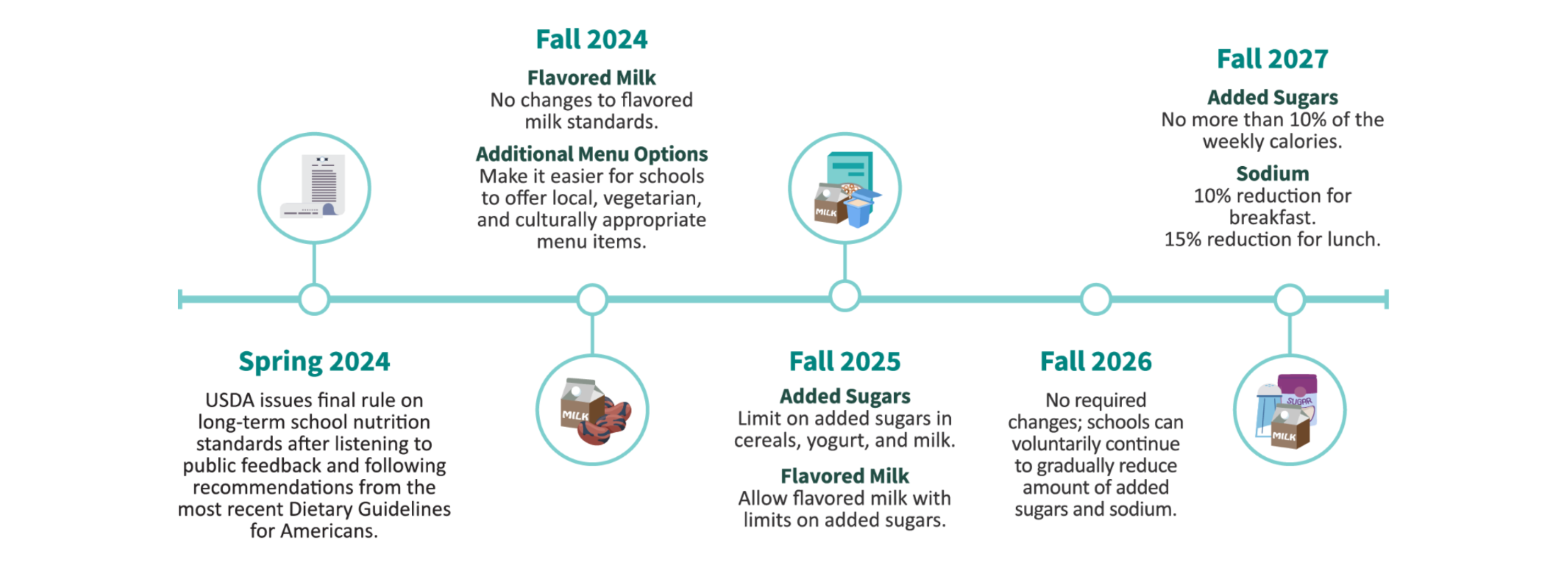USDA Updates School Meal Nutrition Standards in Final Ruling
The US Department of Agriculture (USDA) released a final rule on April 24 aligning school meal standards with the 2020–2025 Dietary Guidelines for Americans. The rule introduces mandatory reductions in sugar and sodium in meals served under its Child Nutrition Programs. These standards are mandatory for schools that participate in USDA child nutrition programs to ensure eligibility for federal reimbursement. Every day, school meals serve upwards of 30 million children and function as a critical source of daily nutrition, especially for low-income children. Phased changes are set to begin in school year 2025–2026, with full implementation anticipated by Fall 2027.
Key changes include:
- Sugar: Limits to high-sugar products (cereals, yogurt, flavored milk) and overall weekly limits
- Sodium: Gradually reduce the weekly limit for lunch and breakfast
- Milk: Continue to allow flavored and unflavored milk with new limits on added sugars
- Menu and operational flexibilities: Expand product offerings for meat alternatives and quantifies preferences for American suppliers
The food and beverage industry, including manufacturers and suppliers, will need to adapt by reformulating products to meet new sugar and sodium standards and exploring new product opportunities given the ruling’s menu flexibility. The rule aligns with broader efforts under the Biden–Harris Administration’s strategy on nutrition, influencing ongoing and future market dynamics and regulatory frameworks despite ongoing political debates (e.g., U.S. Farm Bill reauthorization). These updates will necessitate operational shifts and proactive strategy adjustments for all stakeholders involved in US Child Meal Programs.
Issue
The US Department of Agriculture’s Food and Nutrition Service (FNS) has published its final rule, Child Nutrition Programs: Meal Patterns Consistent With the 2020-2025 Dietary Guidelines for Americans, which will take effect on July 1, 2024. This decision phases in required nutrition changes, notably sugar and sodium reductions, to school meal patterns under the USDA’s child nutrition programming. Program operators are not required to make menu changes until school year 2025-2026 at the earliest.
School nutrition professionals, meal service operators, food manufacturers and suppliers, key partners, and technical assistance providers are now tasked with feeding upwards of 30 million children every school day with the updated nutrition standards. School meals are often the most nutritious food source for American children, rating higher in nutrition quality scores than lunches from home or other sources. These gradual changes aim to continue advancing hunger prevention and nutrition security for children in the US.
The regulations come on the heels of proposed 2023 revisions to meal patterns aimed to increase consistency between school nutrition standards and the Dietary Guidelines for Americans, 2020-2025. The new standards also contribute to the Biden-Harris Administration’s National Strategy on Hunger, Nutrition, and Health, which was announced at the White House Conference on Hunger, Nutrition, and Health in 2022. These improvements build on the health and nutrition priorities established during the Obama era and actively counteract the rollbacks to nutrition and school meal programs introduced during the Trump administration.
What Does it Mean?
These standards include updates across categories of nutrition requirements, menu planning flexibilities, and program operations. This quick take summarizes the provisions, and additional details are available on USDA’s School Nutrition Standards webpage.
What’s changed?
- Limits to added sugars: Limits to breakfast cereals (no more than 6 grams of added sugars per dry ounce), yogurt (no more than 12 grams of added sugars per 6 ounces), and flavored milk (no more than 10 grams of added sugars per 8 fluid ounces; for competitive food, no more than 15 grams of added sugars per 12 fluid ounces). Additionally, limits no more than 10 percent of weekly calories in the meals can be from added sugars.
- Milk: Flavored milk (fat-free and low-fat) may still be offered in all K–12 schools. Limits on added sugars for flavored milk must be implemented by SY2025–2026.
- Sodium: Schools have three [school] years to implement a single sodium reduction for school breakfast (10% decrease) and lunch (15% decrease) according to national sodium limits by Age/Grade group.
- Whole grains: No changes.
- Food preferences: Additional flexibilities for menu planning have been provided by allowing for meat and meat alternatives, culturally inclusive meals, vegetable and grain substitutions, and the bean dip exemption (e.g., hummus) for competitive foods.
- Procurement and operations: Phases in a limit to non-domestic food purchases (no more than 5% of total purchase) and increases market opportunities for small- and medium-sized producers.
What’s the implementation timeline?
Schools are not required to make any changes to their menus for the coming school year 2024–25. Changes in the rule will phase in beginning Fall 2025, with full implementation by Fall 2027. Some provisions also impact the Summer Food Service Program (SFSP) and the Child and Adult Care Food Program (CACFP). More information on the provisions for CACFP and SFSP and accompanying timeline for implementation are available.

Why Does it Matter?
Our clients serving (or adjacent to) US Child Meal Programs are likely to be impacted by this ruling, whether through reformulation processes or operational updates.
- Limits could impact offerings like grab-and-go breakfasts (e.g., grain-based desserts), sparking a need for alternative and innovative breakfast models.
- While the Healthy School Milk Commitment aligns with the updated required limits on added sugars for flavored milk, committed companies should ensure alignment with both the commitment and the new ruling.
- Food product availability will require product reformulation, especially for sugar and sodium updates, which will take time and resources.
- New product flexibilities (e.g., meat alternatives and bean dip) may offer food companies additional market opportunities for school breakfast, lunch, and competitive foods.
Additionally, there are some overlapping provisions in the Agriculture Appropriations Act, which were signed into law in March 2024. The milk and sodium provisions are consistent with the Ag Appropriations Act. The vegetables at breakfast option is not fully consistent: in short, for school year 2024–25, schools may offer any vegetable in place of fruit at breakfast.
Where is it Going?
Whether through large-scale updates driven by the USDA or temporary adjustments like those operationalized during the COVID-19 pandemic, core guidelines will continue to change every few years. In the next two years, key moments to watch out for include:
- 2024 US Elections: The incoming administration’s priorities on health, nutrition, and food security could significantly influence regulatory landscapes that may have far-reaching impacts, from market opportunities to consumer preferences. Given these potential changes, it is crucial for companies to proactively monitor these developments to quickly adapt business strategies competitively.
- US Farm Bill Reauthorization: Failure by the US Congress to reach a new reauthorization by September 30, 2024, would necessitate another extension of the 2018 Farm Bill, which serves as the blueprint for bills like the Ag Appropriations Act, which contributes funding to nutrition-focused agencies like the USDA. Congress is actively working on a new bipartisan Farm Bill package, aiming for a five-year reauthorization. Although the 2024 reauthorization is expected, it faces obstacles, including conflicts over government spending and disagreements regarding mandatory nutrition funding.
- Stakeholder Demand: Consumers, policymakers, academics, and the media are increasing pressure on food and beverage manufacturers, especially on topics like sugar, salt, fat, and processed foods. Companies, and the trade groups that represent them, will continue to be tasked with responding to this demand.
- 2025–2030 Dietary Guidelines: These guidelines, which are currently in development, shape regulatory standards for labeling, marketing, and product access—driving consumer health trends and influencing product formulation and business strategies in the industry. This pivotal update can significantly impact compliance, market positioning, and innovation in food products, as we’ve seen with this current ruling.
For more information, contact EGA’s Abigail Reich, Director of Food and Beverage Abigail.Reich@edelmanega.com.










